GCNRN4 Research Proposal: Healthcare Professionals & HAIs
VerifiedAdded on 2023/04/03
|16
|3207
|83
Project
AI Summary
This research proposal, developed for the GCNRN4 Research in Nursing unit at the Institute of Health and Management (IHM), focuses on the perceptions of healthcare professionals regarding hospital-acquired infections (HAIs) and evidence-based infection control strategies. The proposal introduces HAIs, also known as nosocomial infections, and their impact on patient outcomes, referencing statistics from the CDC and WHO. It outlines the problem statement, highlighting the rising prevalence of HAIs in Australia and the need for improved infection control practices. The research aims to address the research question: "What are the perceptions of health care professionals in relation to hospital-acquired infections and evidence-based infection- control strategies?" The proposal includes a literature review emphasizing the importance of hand hygiene and other infection control measures. The research design will employ a qualitative approach using a grounded theory perspective, involving semi-structured interviews with healthcare professionals. The proposal also discusses the conceptual framework, research rationale, and potential implications for improving infection control practices and patient outcomes. The proposal is based on the grounded theory framework, and the researcher plans to collect data through semi-structured interviews. The findings will be analyzed to identify barriers and improve compliance with infection control policies.
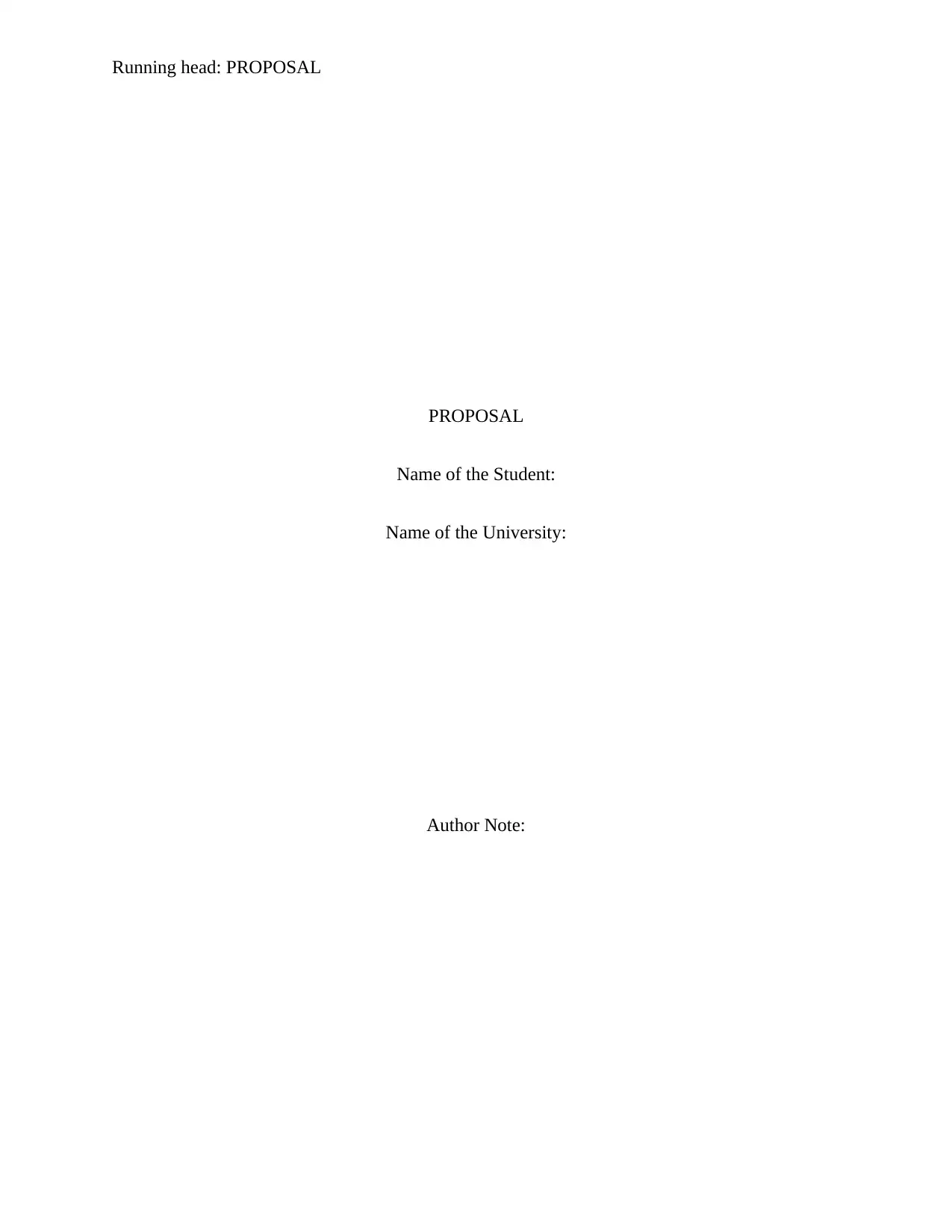
Running head: PROPOSAL
PROPOSAL
Name of the Student:
Name of the University:
Author Note:
PROPOSAL
Name of the Student:
Name of the University:
Author Note:
Paraphrase This Document
Need a fresh take? Get an instant paraphrase of this document with our AI Paraphraser
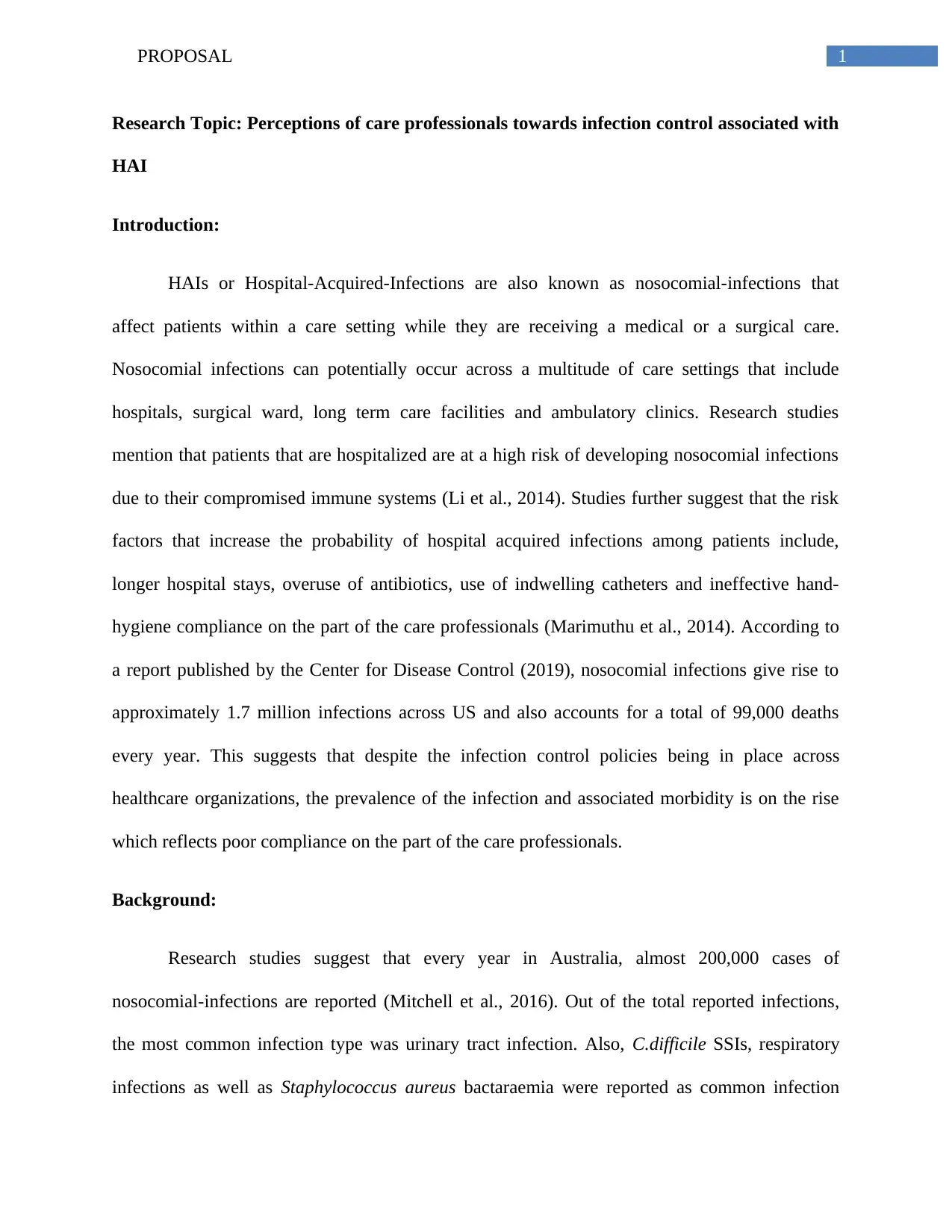
1PROPOSAL
Research Topic: Perceptions of care professionals towards infection control associated with
HAI
Introduction:
HAIs or Hospital-Acquired-Infections are also known as nosocomial-infections that
affect patients within a care setting while they are receiving a medical or a surgical care.
Nosocomial infections can potentially occur across a multitude of care settings that include
hospitals, surgical ward, long term care facilities and ambulatory clinics. Research studies
mention that patients that are hospitalized are at a high risk of developing nosocomial infections
due to their compromised immune systems (Li et al., 2014). Studies further suggest that the risk
factors that increase the probability of hospital acquired infections among patients include,
longer hospital stays, overuse of antibiotics, use of indwelling catheters and ineffective hand-
hygiene compliance on the part of the care professionals (Marimuthu et al., 2014). According to
a report published by the Center for Disease Control (2019), nosocomial infections give rise to
approximately 1.7 million infections across US and also accounts for a total of 99,000 deaths
every year. This suggests that despite the infection control policies being in place across
healthcare organizations, the prevalence of the infection and associated morbidity is on the rise
which reflects poor compliance on the part of the care professionals.
Background:
Research studies suggest that every year in Australia, almost 200,000 cases of
nosocomial-infections are reported (Mitchell et al., 2016). Out of the total reported infections,
the most common infection type was urinary tract infection. Also, C.difficile SSIs, respiratory
infections as well as Staphylococcus aureus bactaraemia were reported as common infection
Research Topic: Perceptions of care professionals towards infection control associated with
HAI
Introduction:
HAIs or Hospital-Acquired-Infections are also known as nosocomial-infections that
affect patients within a care setting while they are receiving a medical or a surgical care.
Nosocomial infections can potentially occur across a multitude of care settings that include
hospitals, surgical ward, long term care facilities and ambulatory clinics. Research studies
mention that patients that are hospitalized are at a high risk of developing nosocomial infections
due to their compromised immune systems (Li et al., 2014). Studies further suggest that the risk
factors that increase the probability of hospital acquired infections among patients include,
longer hospital stays, overuse of antibiotics, use of indwelling catheters and ineffective hand-
hygiene compliance on the part of the care professionals (Marimuthu et al., 2014). According to
a report published by the Center for Disease Control (2019), nosocomial infections give rise to
approximately 1.7 million infections across US and also accounts for a total of 99,000 deaths
every year. This suggests that despite the infection control policies being in place across
healthcare organizations, the prevalence of the infection and associated morbidity is on the rise
which reflects poor compliance on the part of the care professionals.
Background:
Research studies suggest that every year in Australia, almost 200,000 cases of
nosocomial-infections are reported (Mitchell et al., 2016). Out of the total reported infections,
the most common infection type was urinary tract infection. Also, C.difficile SSIs, respiratory
infections as well as Staphylococcus aureus bactaraemia were reported as common infection
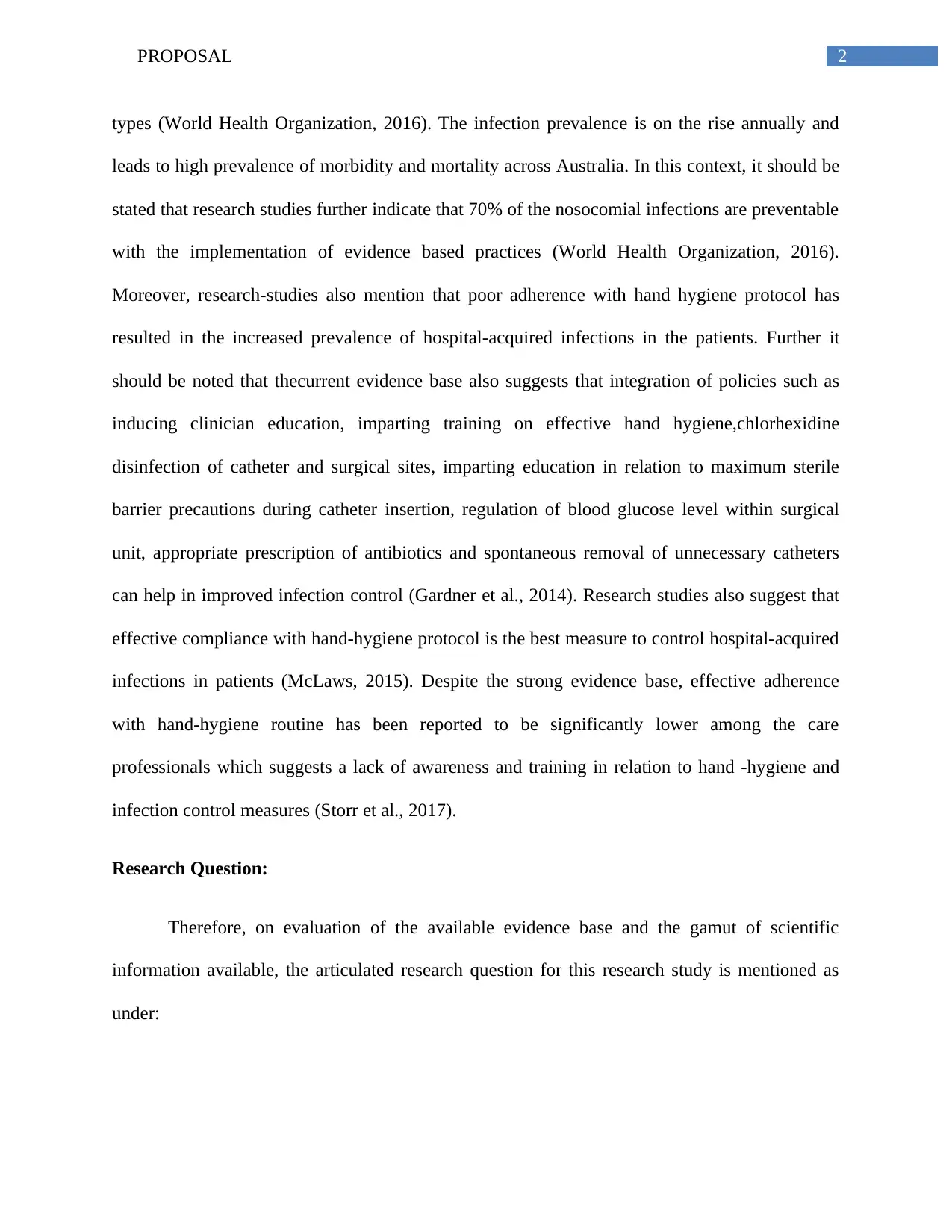
2PROPOSAL
types (World Health Organization, 2016). The infection prevalence is on the rise annually and
leads to high prevalence of morbidity and mortality across Australia. In this context, it should be
stated that research studies further indicate that 70% of the nosocomial infections are preventable
with the implementation of evidence based practices (World Health Organization, 2016).
Moreover, research-studies also mention that poor adherence with hand hygiene protocol has
resulted in the increased prevalence of hospital-acquired infections in the patients. Further it
should be noted that thecurrent evidence base also suggests that integration of policies such as
inducing clinician education, imparting training on effective hand hygiene,chlorhexidine
disinfection of catheter and surgical sites, imparting education in relation to maximum sterile
barrier precautions during catheter insertion, regulation of blood glucose level within surgical
unit, appropriate prescription of antibiotics and spontaneous removal of unnecessary catheters
can help in improved infection control (Gardner et al., 2014). Research studies also suggest that
effective compliance with hand-hygiene protocol is the best measure to control hospital-acquired
infections in patients (McLaws, 2015). Despite the strong evidence base, effective adherence
with hand-hygiene routine has been reported to be significantly lower among the care
professionals which suggests a lack of awareness and training in relation to hand -hygiene and
infection control measures (Storr et al., 2017).
Research Question:
Therefore, on evaluation of the available evidence base and the gamut of scientific
information available, the articulated research question for this research study is mentioned as
under:
types (World Health Organization, 2016). The infection prevalence is on the rise annually and
leads to high prevalence of morbidity and mortality across Australia. In this context, it should be
stated that research studies further indicate that 70% of the nosocomial infections are preventable
with the implementation of evidence based practices (World Health Organization, 2016).
Moreover, research-studies also mention that poor adherence with hand hygiene protocol has
resulted in the increased prevalence of hospital-acquired infections in the patients. Further it
should be noted that thecurrent evidence base also suggests that integration of policies such as
inducing clinician education, imparting training on effective hand hygiene,chlorhexidine
disinfection of catheter and surgical sites, imparting education in relation to maximum sterile
barrier precautions during catheter insertion, regulation of blood glucose level within surgical
unit, appropriate prescription of antibiotics and spontaneous removal of unnecessary catheters
can help in improved infection control (Gardner et al., 2014). Research studies also suggest that
effective compliance with hand-hygiene protocol is the best measure to control hospital-acquired
infections in patients (McLaws, 2015). Despite the strong evidence base, effective adherence
with hand-hygiene routine has been reported to be significantly lower among the care
professionals which suggests a lack of awareness and training in relation to hand -hygiene and
infection control measures (Storr et al., 2017).
Research Question:
Therefore, on evaluation of the available evidence base and the gamut of scientific
information available, the articulated research question for this research study is mentioned as
under:
⊘ This is a preview!⊘
Do you want full access?
Subscribe today to unlock all pages.

Trusted by 1+ million students worldwide
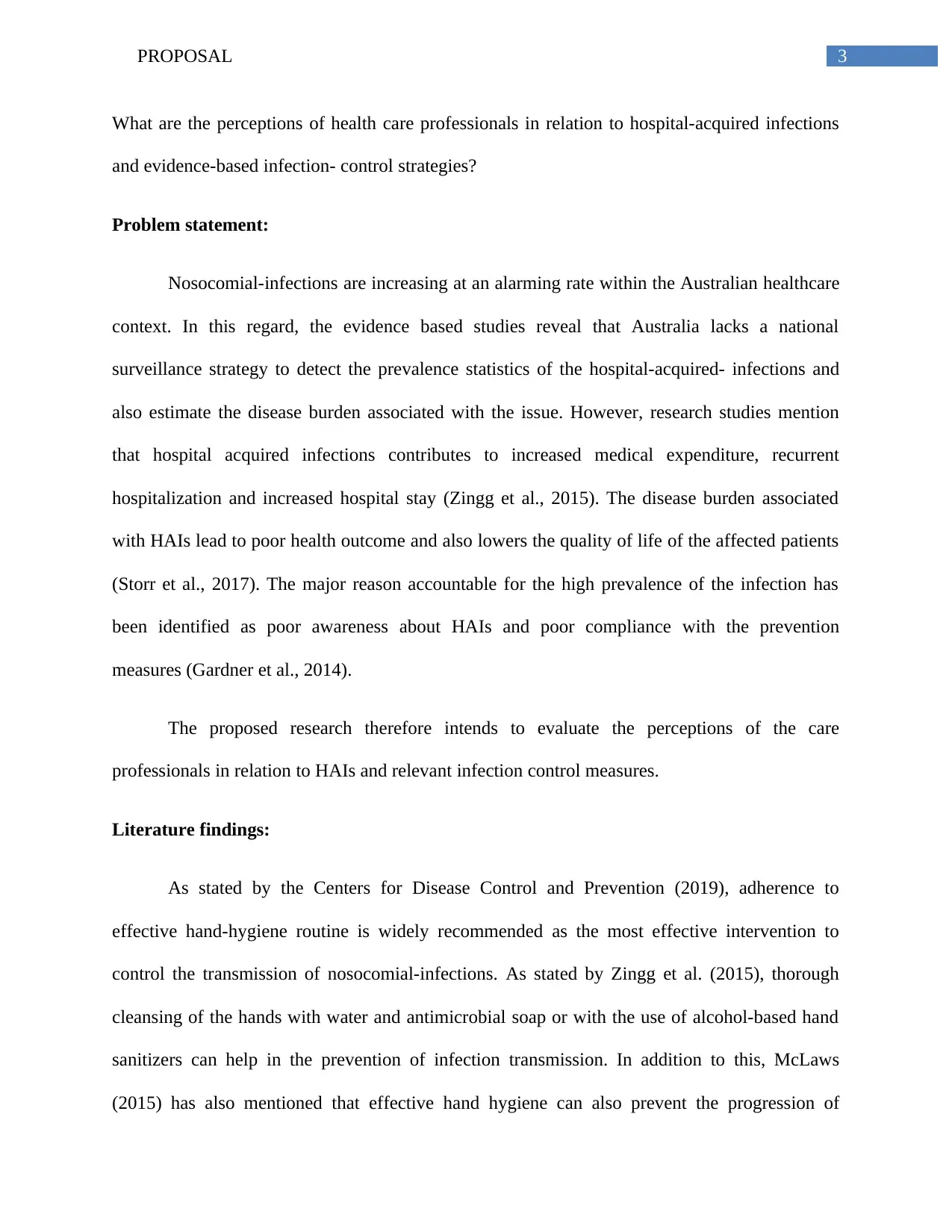
3PROPOSAL
What are the perceptions of health care professionals in relation to hospital-acquired infections
and evidence-based infection- control strategies?
Problem statement:
Nosocomial-infections are increasing at an alarming rate within the Australian healthcare
context. In this regard, the evidence based studies reveal that Australia lacks a national
surveillance strategy to detect the prevalence statistics of the hospital-acquired- infections and
also estimate the disease burden associated with the issue. However, research studies mention
that hospital acquired infections contributes to increased medical expenditure, recurrent
hospitalization and increased hospital stay (Zingg et al., 2015). The disease burden associated
with HAIs lead to poor health outcome and also lowers the quality of life of the affected patients
(Storr et al., 2017). The major reason accountable for the high prevalence of the infection has
been identified as poor awareness about HAIs and poor compliance with the prevention
measures (Gardner et al., 2014).
The proposed research therefore intends to evaluate the perceptions of the care
professionals in relation to HAIs and relevant infection control measures.
Literature findings:
As stated by the Centers for Disease Control and Prevention (2019), adherence to
effective hand-hygiene routine is widely recommended as the most effective intervention to
control the transmission of nosocomial-infections. As stated by Zingg et al. (2015), thorough
cleansing of the hands with water and antimicrobial soap or with the use of alcohol-based hand
sanitizers can help in the prevention of infection transmission. In addition to this, McLaws
(2015) has also mentioned that effective hand hygiene can also prevent the progression of
What are the perceptions of health care professionals in relation to hospital-acquired infections
and evidence-based infection- control strategies?
Problem statement:
Nosocomial-infections are increasing at an alarming rate within the Australian healthcare
context. In this regard, the evidence based studies reveal that Australia lacks a national
surveillance strategy to detect the prevalence statistics of the hospital-acquired- infections and
also estimate the disease burden associated with the issue. However, research studies mention
that hospital acquired infections contributes to increased medical expenditure, recurrent
hospitalization and increased hospital stay (Zingg et al., 2015). The disease burden associated
with HAIs lead to poor health outcome and also lowers the quality of life of the affected patients
(Storr et al., 2017). The major reason accountable for the high prevalence of the infection has
been identified as poor awareness about HAIs and poor compliance with the prevention
measures (Gardner et al., 2014).
The proposed research therefore intends to evaluate the perceptions of the care
professionals in relation to HAIs and relevant infection control measures.
Literature findings:
As stated by the Centers for Disease Control and Prevention (2019), adherence to
effective hand-hygiene routine is widely recommended as the most effective intervention to
control the transmission of nosocomial-infections. As stated by Zingg et al. (2015), thorough
cleansing of the hands with water and antimicrobial soap or with the use of alcohol-based hand
sanitizers can help in the prevention of infection transmission. In addition to this, McLaws
(2015) has also mentioned that effective hand hygiene can also prevent the progression of
Paraphrase This Document
Need a fresh take? Get an instant paraphrase of this document with our AI Paraphraser
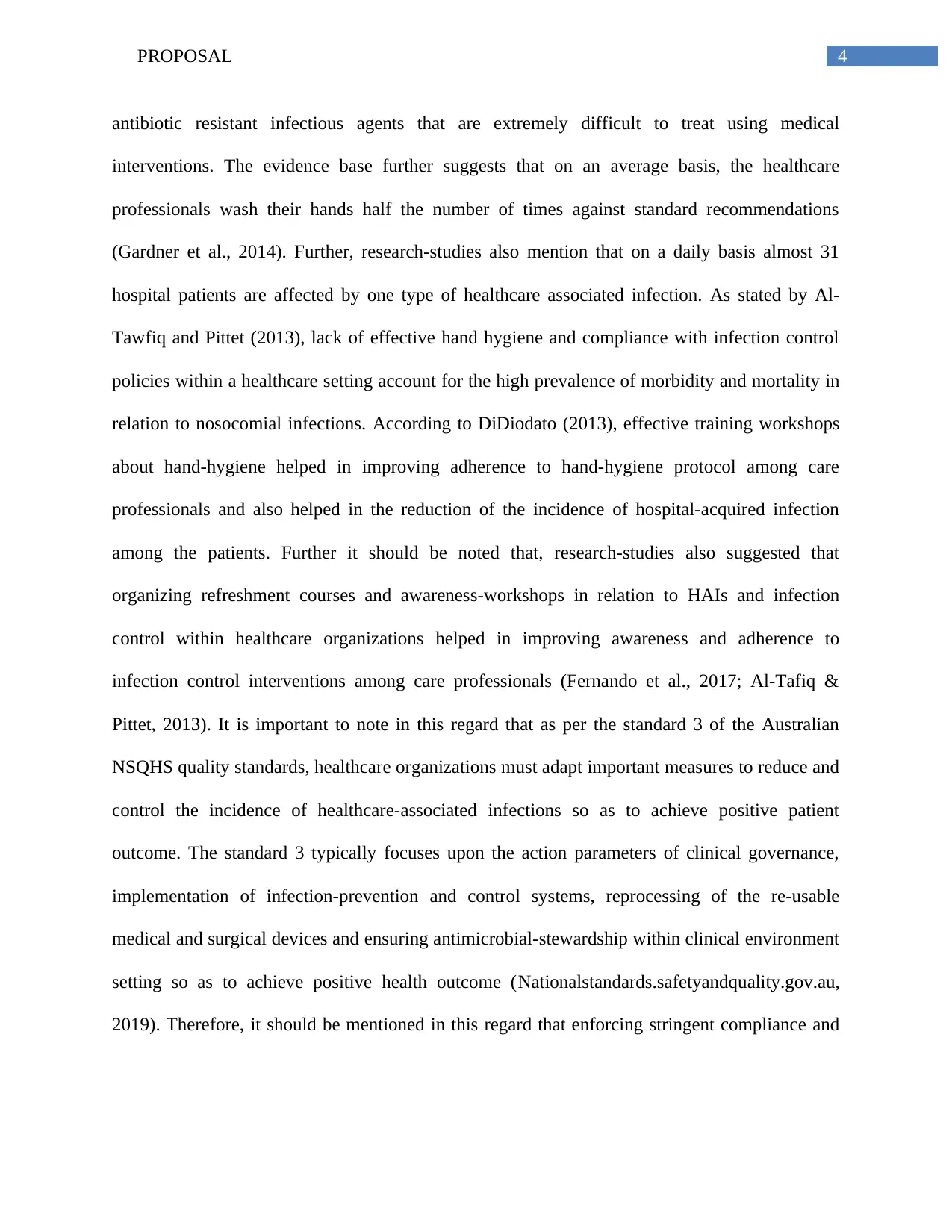
4PROPOSAL
antibiotic resistant infectious agents that are extremely difficult to treat using medical
interventions. The evidence base further suggests that on an average basis, the healthcare
professionals wash their hands half the number of times against standard recommendations
(Gardner et al., 2014). Further, research-studies also mention that on a daily basis almost 31
hospital patients are affected by one type of healthcare associated infection. As stated by Al-
Tawfiq and Pittet (2013), lack of effective hand hygiene and compliance with infection control
policies within a healthcare setting account for the high prevalence of morbidity and mortality in
relation to nosocomial infections. According to DiDiodato (2013), effective training workshops
about hand-hygiene helped in improving adherence to hand-hygiene protocol among care
professionals and also helped in the reduction of the incidence of hospital-acquired infection
among the patients. Further it should be noted that, research-studies also suggested that
organizing refreshment courses and awareness-workshops in relation to HAIs and infection
control within healthcare organizations helped in improving awareness and adherence to
infection control interventions among care professionals (Fernando et al., 2017; Al-Tafiq &
Pittet, 2013). It is important to note in this regard that as per the standard 3 of the Australian
NSQHS quality standards, healthcare organizations must adapt important measures to reduce and
control the incidence of healthcare-associated infections so as to achieve positive patient
outcome. The standard 3 typically focuses upon the action parameters of clinical governance,
implementation of infection-prevention and control systems, reprocessing of the re-usable
medical and surgical devices and ensuring antimicrobial-stewardship within clinical environment
setting so as to achieve positive health outcome (Nationalstandards.safetyandquality.gov.au,
2019). Therefore, it should be mentioned in this regard that enforcing stringent compliance and
antibiotic resistant infectious agents that are extremely difficult to treat using medical
interventions. The evidence base further suggests that on an average basis, the healthcare
professionals wash their hands half the number of times against standard recommendations
(Gardner et al., 2014). Further, research-studies also mention that on a daily basis almost 31
hospital patients are affected by one type of healthcare associated infection. As stated by Al-
Tawfiq and Pittet (2013), lack of effective hand hygiene and compliance with infection control
policies within a healthcare setting account for the high prevalence of morbidity and mortality in
relation to nosocomial infections. According to DiDiodato (2013), effective training workshops
about hand-hygiene helped in improving adherence to hand-hygiene protocol among care
professionals and also helped in the reduction of the incidence of hospital-acquired infection
among the patients. Further it should be noted that, research-studies also suggested that
organizing refreshment courses and awareness-workshops in relation to HAIs and infection
control within healthcare organizations helped in improving awareness and adherence to
infection control interventions among care professionals (Fernando et al., 2017; Al-Tafiq &
Pittet, 2013). It is important to note in this regard that as per the standard 3 of the Australian
NSQHS quality standards, healthcare organizations must adapt important measures to reduce and
control the incidence of healthcare-associated infections so as to achieve positive patient
outcome. The standard 3 typically focuses upon the action parameters of clinical governance,
implementation of infection-prevention and control systems, reprocessing of the re-usable
medical and surgical devices and ensuring antimicrobial-stewardship within clinical environment
setting so as to achieve positive health outcome (Nationalstandards.safetyandquality.gov.au,
2019). Therefore, it should be mentioned in this regard that enforcing stringent compliance and

5PROPOSAL
imparting effective training about infection control can help in achieving positive patient
outcome and at the same time also ensure increased safety measures.
imparting effective training about infection control can help in achieving positive patient
outcome and at the same time also ensure increased safety measures.
⊘ This is a preview!⊘
Do you want full access?
Subscribe today to unlock all pages.

Trusted by 1+ million students worldwide
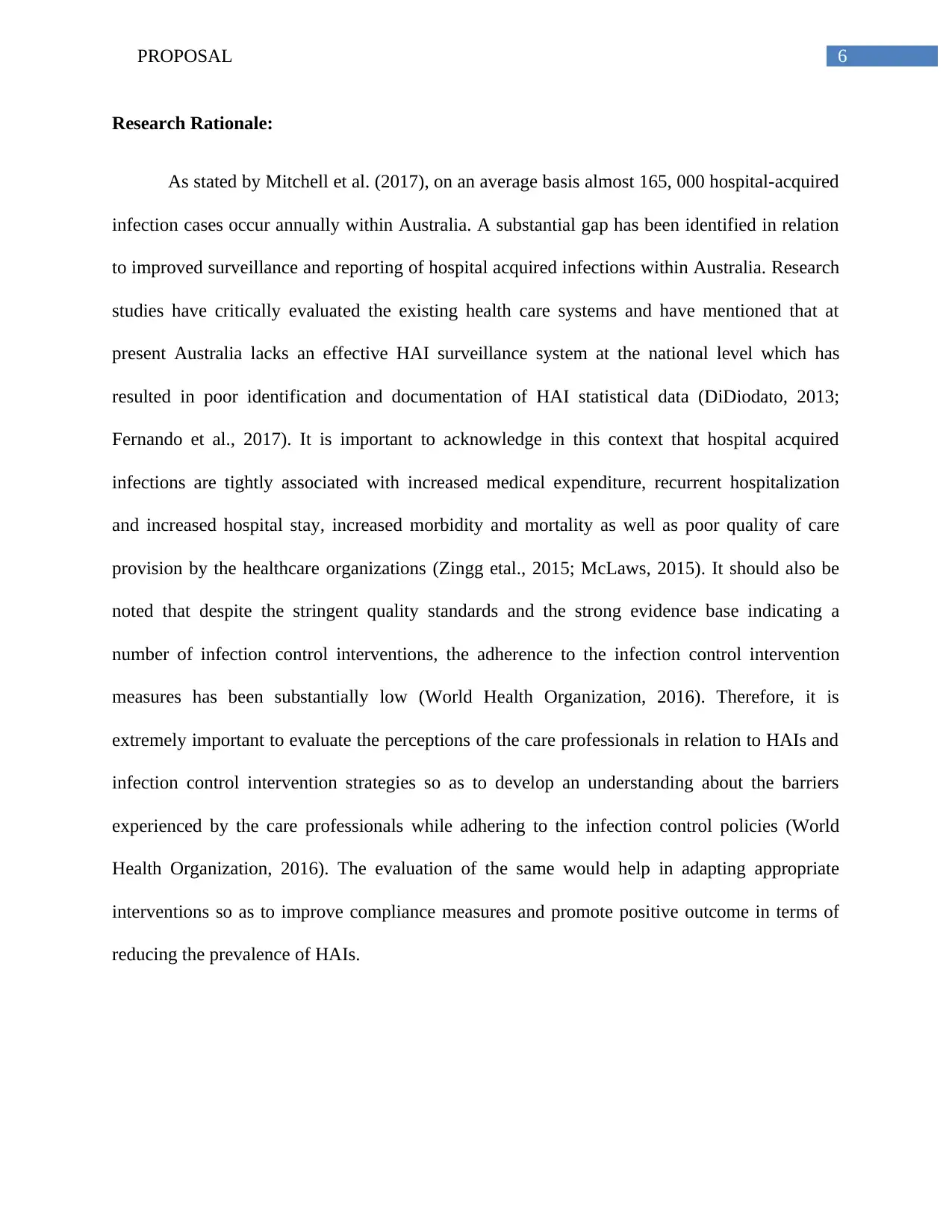
6PROPOSAL
Research Rationale:
As stated by Mitchell et al. (2017), on an average basis almost 165, 000 hospital-acquired
infection cases occur annually within Australia. A substantial gap has been identified in relation
to improved surveillance and reporting of hospital acquired infections within Australia. Research
studies have critically evaluated the existing health care systems and have mentioned that at
present Australia lacks an effective HAI surveillance system at the national level which has
resulted in poor identification and documentation of HAI statistical data (DiDiodato, 2013;
Fernando et al., 2017). It is important to acknowledge in this context that hospital acquired
infections are tightly associated with increased medical expenditure, recurrent hospitalization
and increased hospital stay, increased morbidity and mortality as well as poor quality of care
provision by the healthcare organizations (Zingg etal., 2015; McLaws, 2015). It should also be
noted that despite the stringent quality standards and the strong evidence base indicating a
number of infection control interventions, the adherence to the infection control intervention
measures has been substantially low (World Health Organization, 2016). Therefore, it is
extremely important to evaluate the perceptions of the care professionals in relation to HAIs and
infection control intervention strategies so as to develop an understanding about the barriers
experienced by the care professionals while adhering to the infection control policies (World
Health Organization, 2016). The evaluation of the same would help in adapting appropriate
interventions so as to improve compliance measures and promote positive outcome in terms of
reducing the prevalence of HAIs.
Research Rationale:
As stated by Mitchell et al. (2017), on an average basis almost 165, 000 hospital-acquired
infection cases occur annually within Australia. A substantial gap has been identified in relation
to improved surveillance and reporting of hospital acquired infections within Australia. Research
studies have critically evaluated the existing health care systems and have mentioned that at
present Australia lacks an effective HAI surveillance system at the national level which has
resulted in poor identification and documentation of HAI statistical data (DiDiodato, 2013;
Fernando et al., 2017). It is important to acknowledge in this context that hospital acquired
infections are tightly associated with increased medical expenditure, recurrent hospitalization
and increased hospital stay, increased morbidity and mortality as well as poor quality of care
provision by the healthcare organizations (Zingg etal., 2015; McLaws, 2015). It should also be
noted that despite the stringent quality standards and the strong evidence base indicating a
number of infection control interventions, the adherence to the infection control intervention
measures has been substantially low (World Health Organization, 2016). Therefore, it is
extremely important to evaluate the perceptions of the care professionals in relation to HAIs and
infection control intervention strategies so as to develop an understanding about the barriers
experienced by the care professionals while adhering to the infection control policies (World
Health Organization, 2016). The evaluation of the same would help in adapting appropriate
interventions so as to improve compliance measures and promote positive outcome in terms of
reducing the prevalence of HAIs.
Paraphrase This Document
Need a fresh take? Get an instant paraphrase of this document with our AI Paraphraser
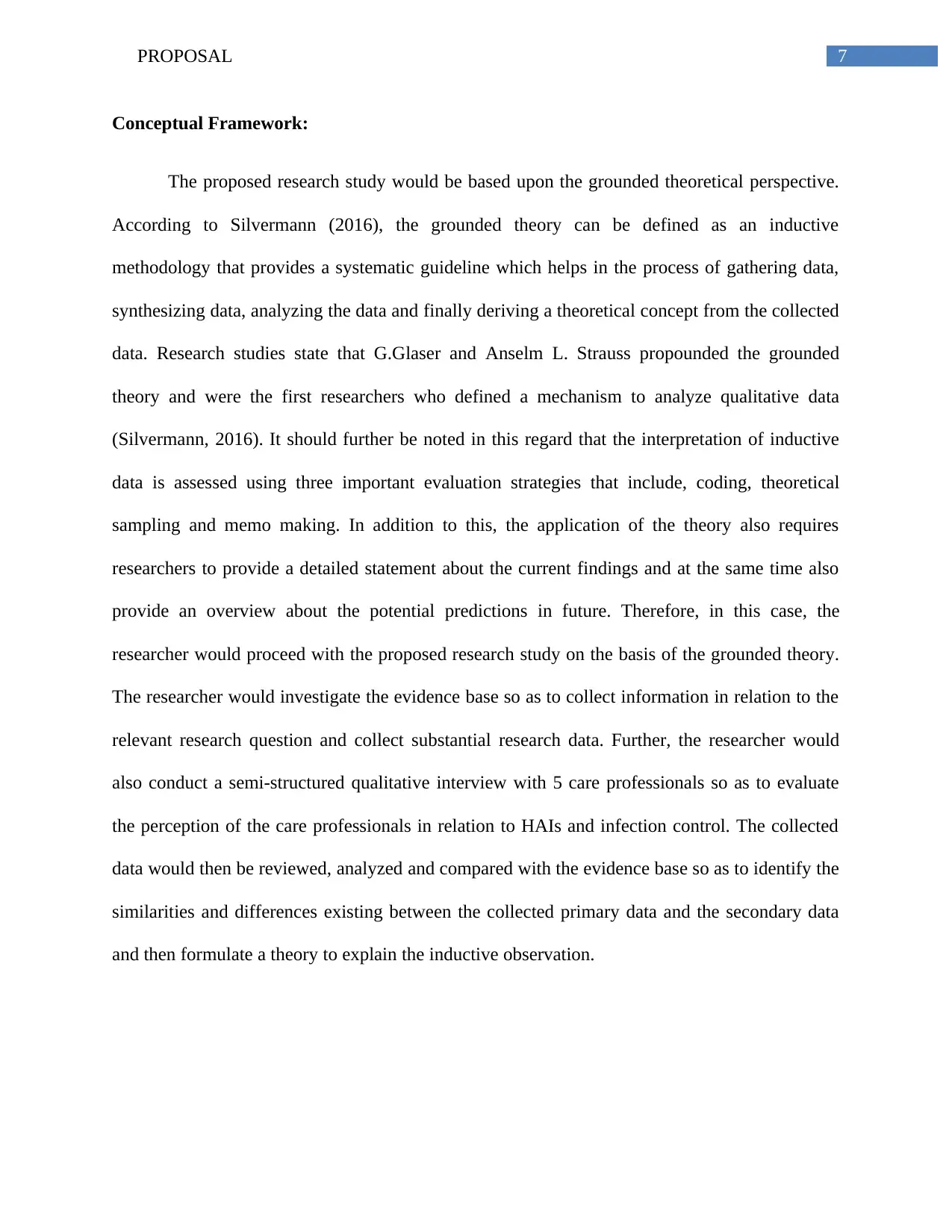
7PROPOSAL
Conceptual Framework:
The proposed research study would be based upon the grounded theoretical perspective.
According to Silvermann (2016), the grounded theory can be defined as an inductive
methodology that provides a systematic guideline which helps in the process of gathering data,
synthesizing data, analyzing the data and finally deriving a theoretical concept from the collected
data. Research studies state that G.Glaser and Anselm L. Strauss propounded the grounded
theory and were the first researchers who defined a mechanism to analyze qualitative data
(Silvermann, 2016). It should further be noted in this regard that the interpretation of inductive
data is assessed using three important evaluation strategies that include, coding, theoretical
sampling and memo making. In addition to this, the application of the theory also requires
researchers to provide a detailed statement about the current findings and at the same time also
provide an overview about the potential predictions in future. Therefore, in this case, the
researcher would proceed with the proposed research study on the basis of the grounded theory.
The researcher would investigate the evidence base so as to collect information in relation to the
relevant research question and collect substantial research data. Further, the researcher would
also conduct a semi-structured qualitative interview with 5 care professionals so as to evaluate
the perception of the care professionals in relation to HAIs and infection control. The collected
data would then be reviewed, analyzed and compared with the evidence base so as to identify the
similarities and differences existing between the collected primary data and the secondary data
and then formulate a theory to explain the inductive observation.
Conceptual Framework:
The proposed research study would be based upon the grounded theoretical perspective.
According to Silvermann (2016), the grounded theory can be defined as an inductive
methodology that provides a systematic guideline which helps in the process of gathering data,
synthesizing data, analyzing the data and finally deriving a theoretical concept from the collected
data. Research studies state that G.Glaser and Anselm L. Strauss propounded the grounded
theory and were the first researchers who defined a mechanism to analyze qualitative data
(Silvermann, 2016). It should further be noted in this regard that the interpretation of inductive
data is assessed using three important evaluation strategies that include, coding, theoretical
sampling and memo making. In addition to this, the application of the theory also requires
researchers to provide a detailed statement about the current findings and at the same time also
provide an overview about the potential predictions in future. Therefore, in this case, the
researcher would proceed with the proposed research study on the basis of the grounded theory.
The researcher would investigate the evidence base so as to collect information in relation to the
relevant research question and collect substantial research data. Further, the researcher would
also conduct a semi-structured qualitative interview with 5 care professionals so as to evaluate
the perception of the care professionals in relation to HAIs and infection control. The collected
data would then be reviewed, analyzed and compared with the evidence base so as to identify the
similarities and differences existing between the collected primary data and the secondary data
and then formulate a theory to explain the inductive observation.
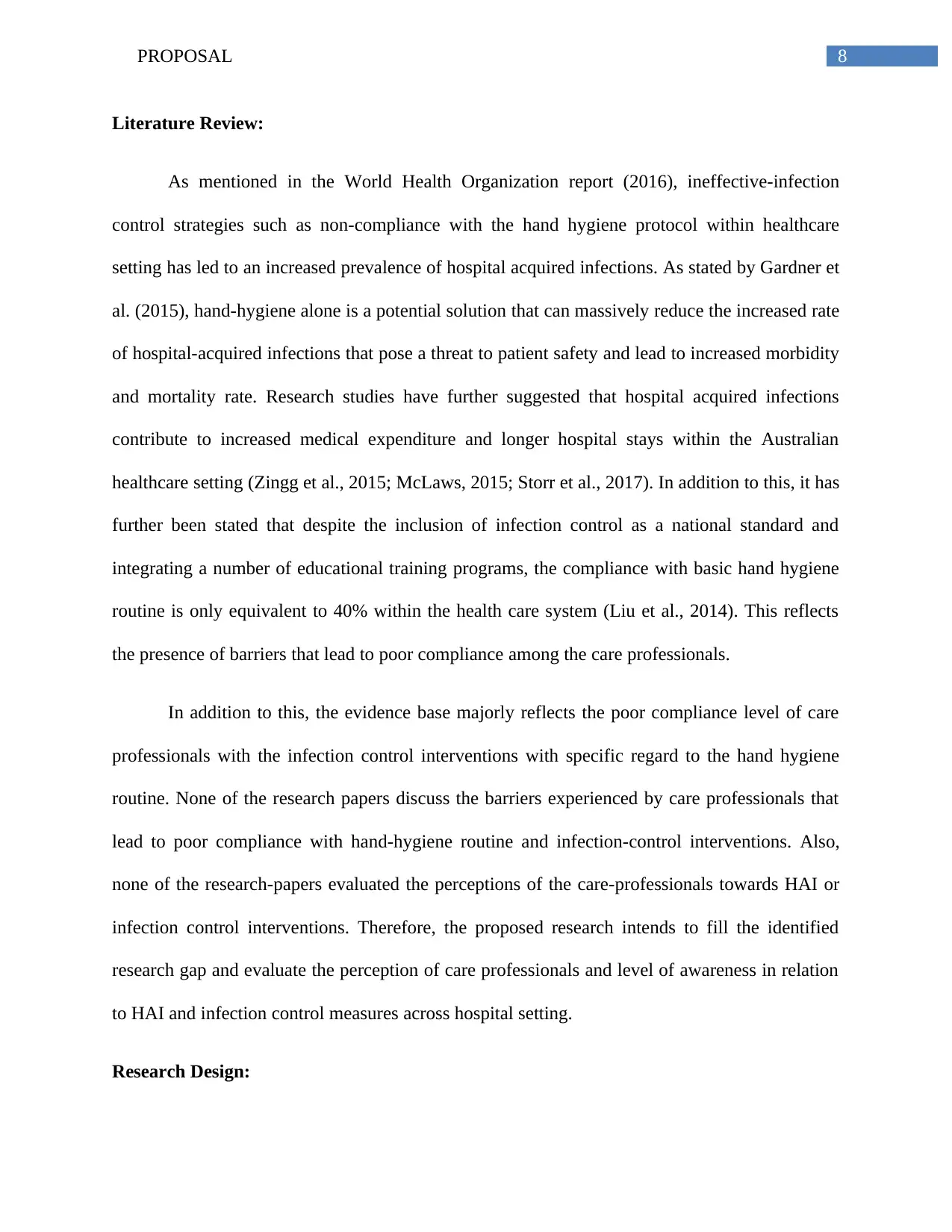
8PROPOSAL
Literature Review:
As mentioned in the World Health Organization report (2016), ineffective-infection
control strategies such as non-compliance with the hand hygiene protocol within healthcare
setting has led to an increased prevalence of hospital acquired infections. As stated by Gardner et
al. (2015), hand-hygiene alone is a potential solution that can massively reduce the increased rate
of hospital-acquired infections that pose a threat to patient safety and lead to increased morbidity
and mortality rate. Research studies have further suggested that hospital acquired infections
contribute to increased medical expenditure and longer hospital stays within the Australian
healthcare setting (Zingg et al., 2015; McLaws, 2015; Storr et al., 2017). In addition to this, it has
further been stated that despite the inclusion of infection control as a national standard and
integrating a number of educational training programs, the compliance with basic hand hygiene
routine is only equivalent to 40% within the health care system (Liu et al., 2014). This reflects
the presence of barriers that lead to poor compliance among the care professionals.
In addition to this, the evidence base majorly reflects the poor compliance level of care
professionals with the infection control interventions with specific regard to the hand hygiene
routine. None of the research papers discuss the barriers experienced by care professionals that
lead to poor compliance with hand-hygiene routine and infection-control interventions. Also,
none of the research-papers evaluated the perceptions of the care-professionals towards HAI or
infection control interventions. Therefore, the proposed research intends to fill the identified
research gap and evaluate the perception of care professionals and level of awareness in relation
to HAI and infection control measures across hospital setting.
Research Design:
Literature Review:
As mentioned in the World Health Organization report (2016), ineffective-infection
control strategies such as non-compliance with the hand hygiene protocol within healthcare
setting has led to an increased prevalence of hospital acquired infections. As stated by Gardner et
al. (2015), hand-hygiene alone is a potential solution that can massively reduce the increased rate
of hospital-acquired infections that pose a threat to patient safety and lead to increased morbidity
and mortality rate. Research studies have further suggested that hospital acquired infections
contribute to increased medical expenditure and longer hospital stays within the Australian
healthcare setting (Zingg et al., 2015; McLaws, 2015; Storr et al., 2017). In addition to this, it has
further been stated that despite the inclusion of infection control as a national standard and
integrating a number of educational training programs, the compliance with basic hand hygiene
routine is only equivalent to 40% within the health care system (Liu et al., 2014). This reflects
the presence of barriers that lead to poor compliance among the care professionals.
In addition to this, the evidence base majorly reflects the poor compliance level of care
professionals with the infection control interventions with specific regard to the hand hygiene
routine. None of the research papers discuss the barriers experienced by care professionals that
lead to poor compliance with hand-hygiene routine and infection-control interventions. Also,
none of the research-papers evaluated the perceptions of the care-professionals towards HAI or
infection control interventions. Therefore, the proposed research intends to fill the identified
research gap and evaluate the perception of care professionals and level of awareness in relation
to HAI and infection control measures across hospital setting.
Research Design:
⊘ This is a preview!⊘
Do you want full access?
Subscribe today to unlock all pages.

Trusted by 1+ million students worldwide
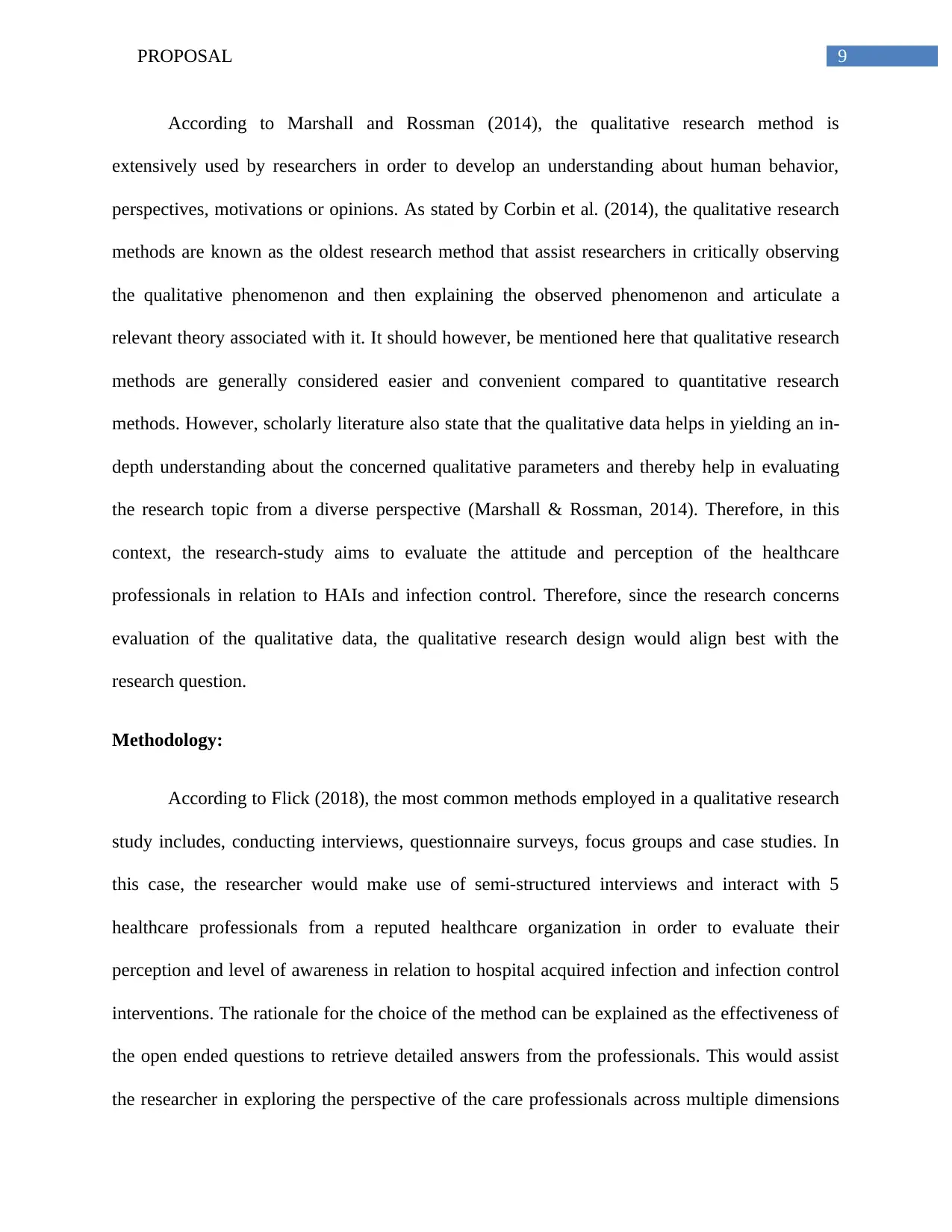
9PROPOSAL
According to Marshall and Rossman (2014), the qualitative research method is
extensively used by researchers in order to develop an understanding about human behavior,
perspectives, motivations or opinions. As stated by Corbin et al. (2014), the qualitative research
methods are known as the oldest research method that assist researchers in critically observing
the qualitative phenomenon and then explaining the observed phenomenon and articulate a
relevant theory associated with it. It should however, be mentioned here that qualitative research
methods are generally considered easier and convenient compared to quantitative research
methods. However, scholarly literature also state that the qualitative data helps in yielding an in-
depth understanding about the concerned qualitative parameters and thereby help in evaluating
the research topic from a diverse perspective (Marshall & Rossman, 2014). Therefore, in this
context, the research-study aims to evaluate the attitude and perception of the healthcare
professionals in relation to HAIs and infection control. Therefore, since the research concerns
evaluation of the qualitative data, the qualitative research design would align best with the
research question.
Methodology:
According to Flick (2018), the most common methods employed in a qualitative research
study includes, conducting interviews, questionnaire surveys, focus groups and case studies. In
this case, the researcher would make use of semi-structured interviews and interact with 5
healthcare professionals from a reputed healthcare organization in order to evaluate their
perception and level of awareness in relation to hospital acquired infection and infection control
interventions. The rationale for the choice of the method can be explained as the effectiveness of
the open ended questions to retrieve detailed answers from the professionals. This would assist
the researcher in exploring the perspective of the care professionals across multiple dimensions
According to Marshall and Rossman (2014), the qualitative research method is
extensively used by researchers in order to develop an understanding about human behavior,
perspectives, motivations or opinions. As stated by Corbin et al. (2014), the qualitative research
methods are known as the oldest research method that assist researchers in critically observing
the qualitative phenomenon and then explaining the observed phenomenon and articulate a
relevant theory associated with it. It should however, be mentioned here that qualitative research
methods are generally considered easier and convenient compared to quantitative research
methods. However, scholarly literature also state that the qualitative data helps in yielding an in-
depth understanding about the concerned qualitative parameters and thereby help in evaluating
the research topic from a diverse perspective (Marshall & Rossman, 2014). Therefore, in this
context, the research-study aims to evaluate the attitude and perception of the healthcare
professionals in relation to HAIs and infection control. Therefore, since the research concerns
evaluation of the qualitative data, the qualitative research design would align best with the
research question.
Methodology:
According to Flick (2018), the most common methods employed in a qualitative research
study includes, conducting interviews, questionnaire surveys, focus groups and case studies. In
this case, the researcher would make use of semi-structured interviews and interact with 5
healthcare professionals from a reputed healthcare organization in order to evaluate their
perception and level of awareness in relation to hospital acquired infection and infection control
interventions. The rationale for the choice of the method can be explained as the effectiveness of
the open ended questions to retrieve detailed answers from the professionals. This would assist
the researcher in exploring the perspective of the care professionals across multiple dimensions
Paraphrase This Document
Need a fresh take? Get an instant paraphrase of this document with our AI Paraphraser
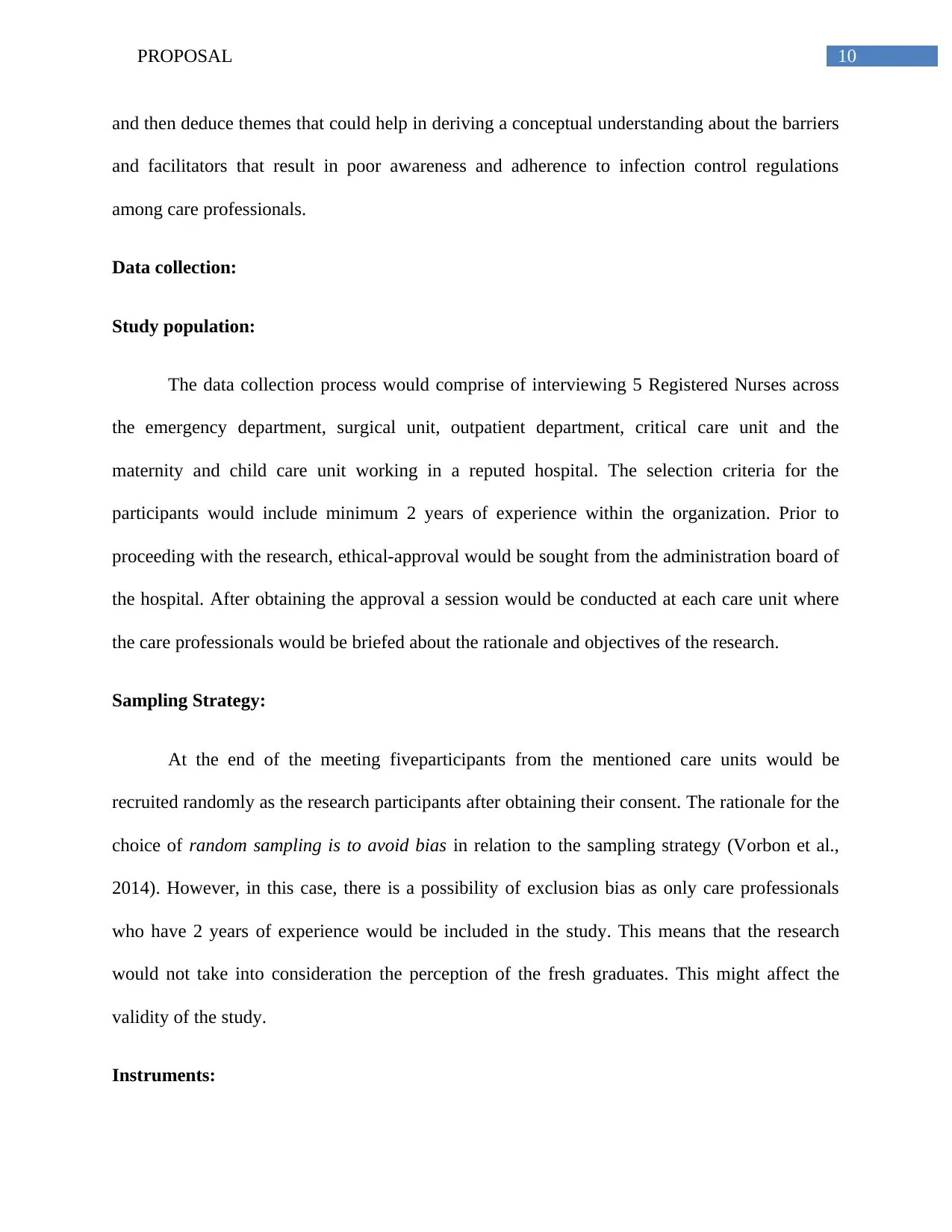
10PROPOSAL
and then deduce themes that could help in deriving a conceptual understanding about the barriers
and facilitators that result in poor awareness and adherence to infection control regulations
among care professionals.
Data collection:
Study population:
The data collection process would comprise of interviewing 5 Registered Nurses across
the emergency department, surgical unit, outpatient department, critical care unit and the
maternity and child care unit working in a reputed hospital. The selection criteria for the
participants would include minimum 2 years of experience within the organization. Prior to
proceeding with the research, ethical-approval would be sought from the administration board of
the hospital. After obtaining the approval a session would be conducted at each care unit where
the care professionals would be briefed about the rationale and objectives of the research.
Sampling Strategy:
At the end of the meeting fiveparticipants from the mentioned care units would be
recruited randomly as the research participants after obtaining their consent. The rationale for the
choice of random sampling is to avoid bias in relation to the sampling strategy (Vorbon et al.,
2014). However, in this case, there is a possibility of exclusion bias as only care professionals
who have 2 years of experience would be included in the study. This means that the research
would not take into consideration the perception of the fresh graduates. This might affect the
validity of the study.
Instruments:
and then deduce themes that could help in deriving a conceptual understanding about the barriers
and facilitators that result in poor awareness and adherence to infection control regulations
among care professionals.
Data collection:
Study population:
The data collection process would comprise of interviewing 5 Registered Nurses across
the emergency department, surgical unit, outpatient department, critical care unit and the
maternity and child care unit working in a reputed hospital. The selection criteria for the
participants would include minimum 2 years of experience within the organization. Prior to
proceeding with the research, ethical-approval would be sought from the administration board of
the hospital. After obtaining the approval a session would be conducted at each care unit where
the care professionals would be briefed about the rationale and objectives of the research.
Sampling Strategy:
At the end of the meeting fiveparticipants from the mentioned care units would be
recruited randomly as the research participants after obtaining their consent. The rationale for the
choice of random sampling is to avoid bias in relation to the sampling strategy (Vorbon et al.,
2014). However, in this case, there is a possibility of exclusion bias as only care professionals
who have 2 years of experience would be included in the study. This means that the research
would not take into consideration the perception of the fresh graduates. This might affect the
validity of the study.
Instruments:
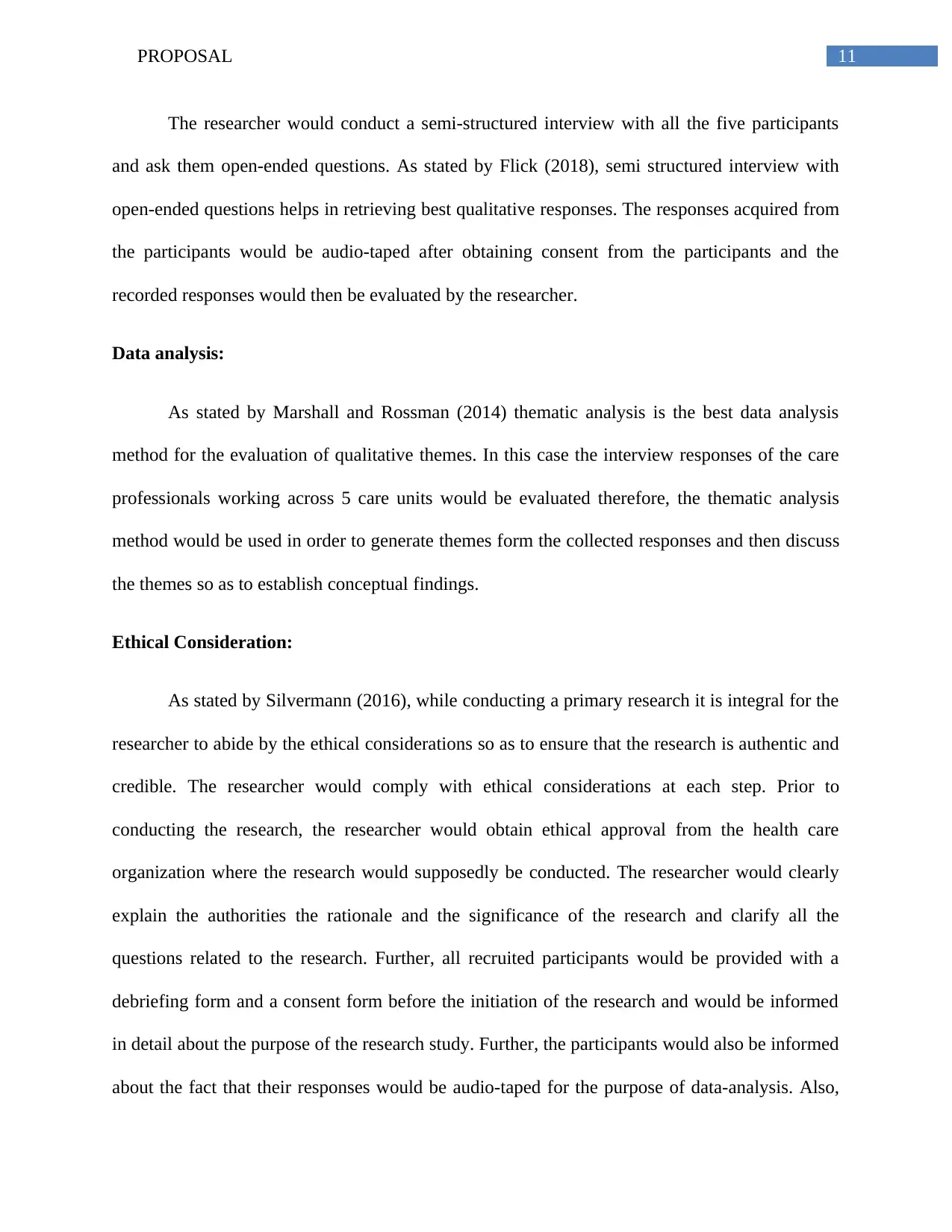
11PROPOSAL
The researcher would conduct a semi-structured interview with all the five participants
and ask them open-ended questions. As stated by Flick (2018), semi structured interview with
open-ended questions helps in retrieving best qualitative responses. The responses acquired from
the participants would be audio-taped after obtaining consent from the participants and the
recorded responses would then be evaluated by the researcher.
Data analysis:
As stated by Marshall and Rossman (2014) thematic analysis is the best data analysis
method for the evaluation of qualitative themes. In this case the interview responses of the care
professionals working across 5 care units would be evaluated therefore, the thematic analysis
method would be used in order to generate themes form the collected responses and then discuss
the themes so as to establish conceptual findings.
Ethical Consideration:
As stated by Silvermann (2016), while conducting a primary research it is integral for the
researcher to abide by the ethical considerations so as to ensure that the research is authentic and
credible. The researcher would comply with ethical considerations at each step. Prior to
conducting the research, the researcher would obtain ethical approval from the health care
organization where the research would supposedly be conducted. The researcher would clearly
explain the authorities the rationale and the significance of the research and clarify all the
questions related to the research. Further, all recruited participants would be provided with a
debriefing form and a consent form before the initiation of the research and would be informed
in detail about the purpose of the research study. Further, the participants would also be informed
about the fact that their responses would be audio-taped for the purpose of data-analysis. Also,
The researcher would conduct a semi-structured interview with all the five participants
and ask them open-ended questions. As stated by Flick (2018), semi structured interview with
open-ended questions helps in retrieving best qualitative responses. The responses acquired from
the participants would be audio-taped after obtaining consent from the participants and the
recorded responses would then be evaluated by the researcher.
Data analysis:
As stated by Marshall and Rossman (2014) thematic analysis is the best data analysis
method for the evaluation of qualitative themes. In this case the interview responses of the care
professionals working across 5 care units would be evaluated therefore, the thematic analysis
method would be used in order to generate themes form the collected responses and then discuss
the themes so as to establish conceptual findings.
Ethical Consideration:
As stated by Silvermann (2016), while conducting a primary research it is integral for the
researcher to abide by the ethical considerations so as to ensure that the research is authentic and
credible. The researcher would comply with ethical considerations at each step. Prior to
conducting the research, the researcher would obtain ethical approval from the health care
organization where the research would supposedly be conducted. The researcher would clearly
explain the authorities the rationale and the significance of the research and clarify all the
questions related to the research. Further, all recruited participants would be provided with a
debriefing form and a consent form before the initiation of the research and would be informed
in detail about the purpose of the research study. Further, the participants would also be informed
about the fact that their responses would be audio-taped for the purpose of data-analysis. Also,
⊘ This is a preview!⊘
Do you want full access?
Subscribe today to unlock all pages.

Trusted by 1+ million students worldwide
1 out of 16
Related Documents
Your All-in-One AI-Powered Toolkit for Academic Success.
+13062052269
info@desklib.com
Available 24*7 on WhatsApp / Email
![[object Object]](/_next/static/media/star-bottom.7253800d.svg)
Unlock your academic potential
Copyright © 2020–2025 A2Z Services. All Rights Reserved. Developed and managed by ZUCOL.





